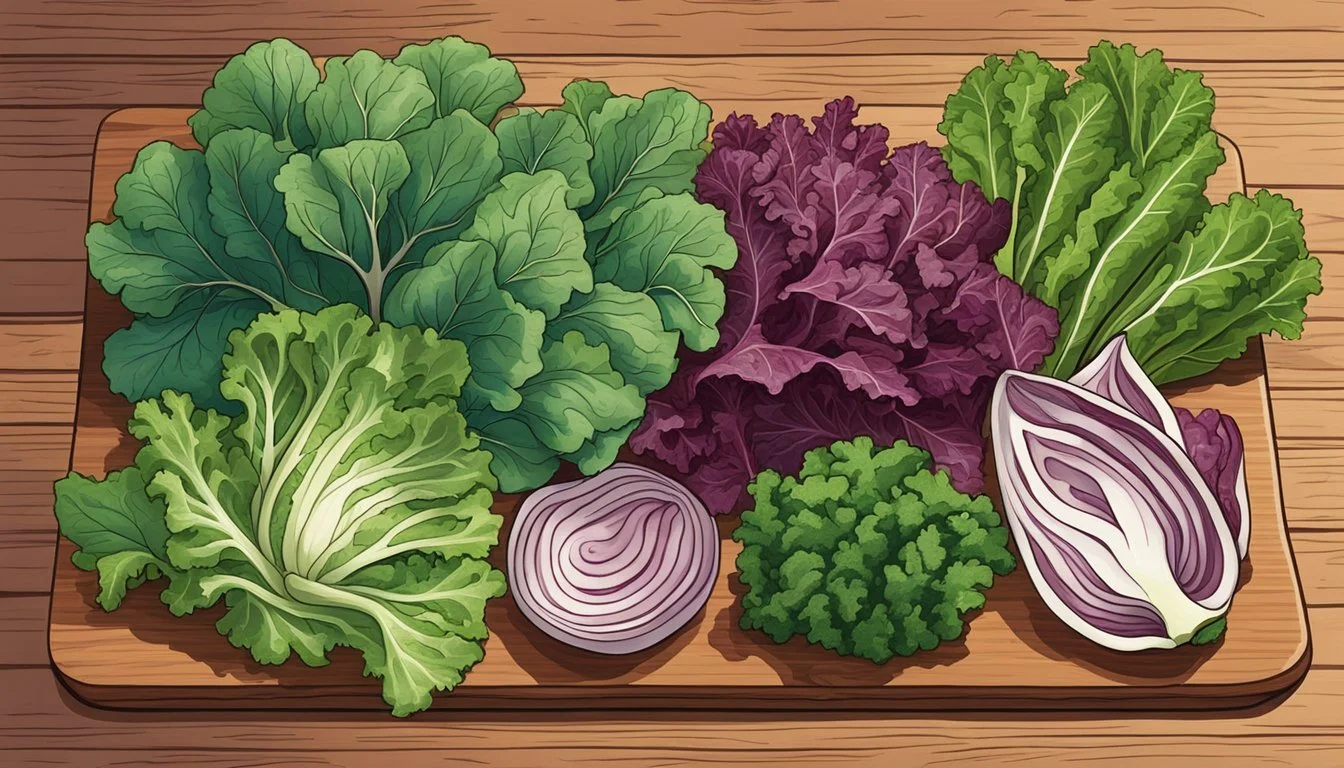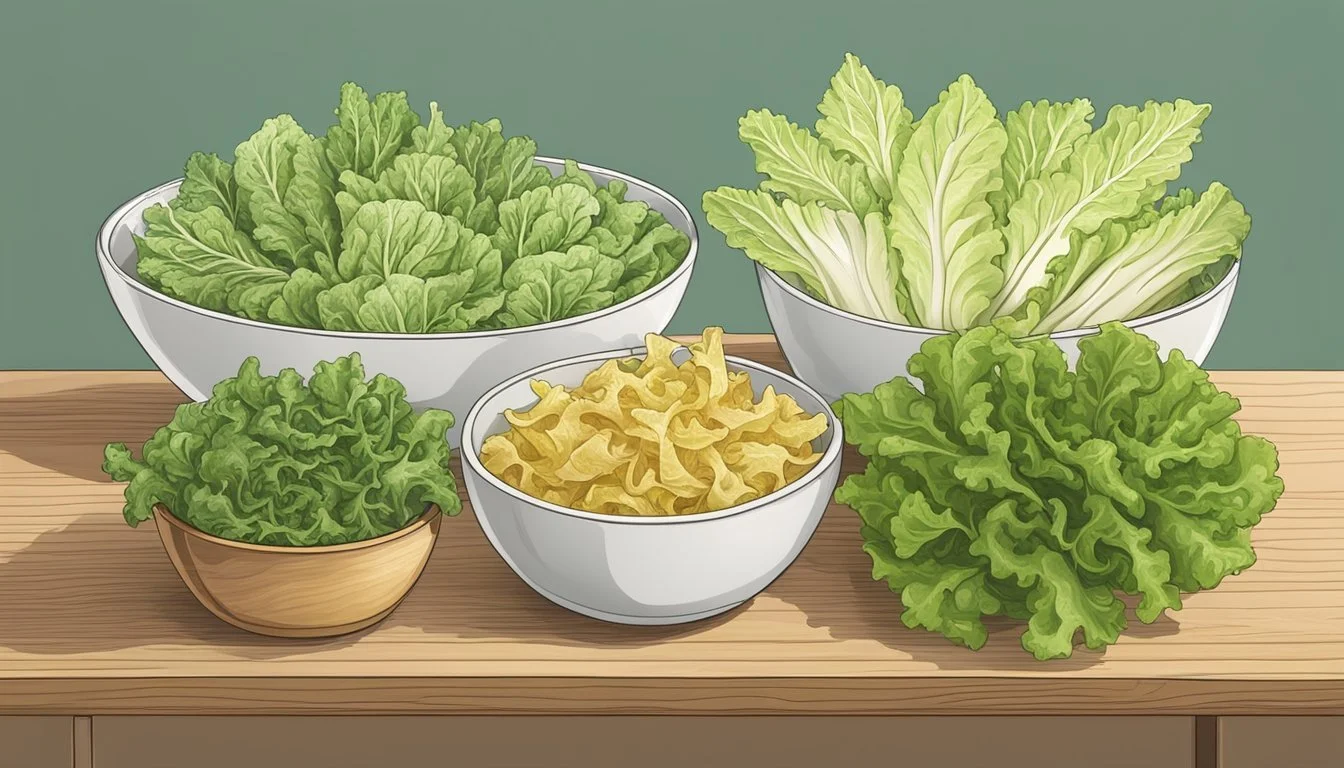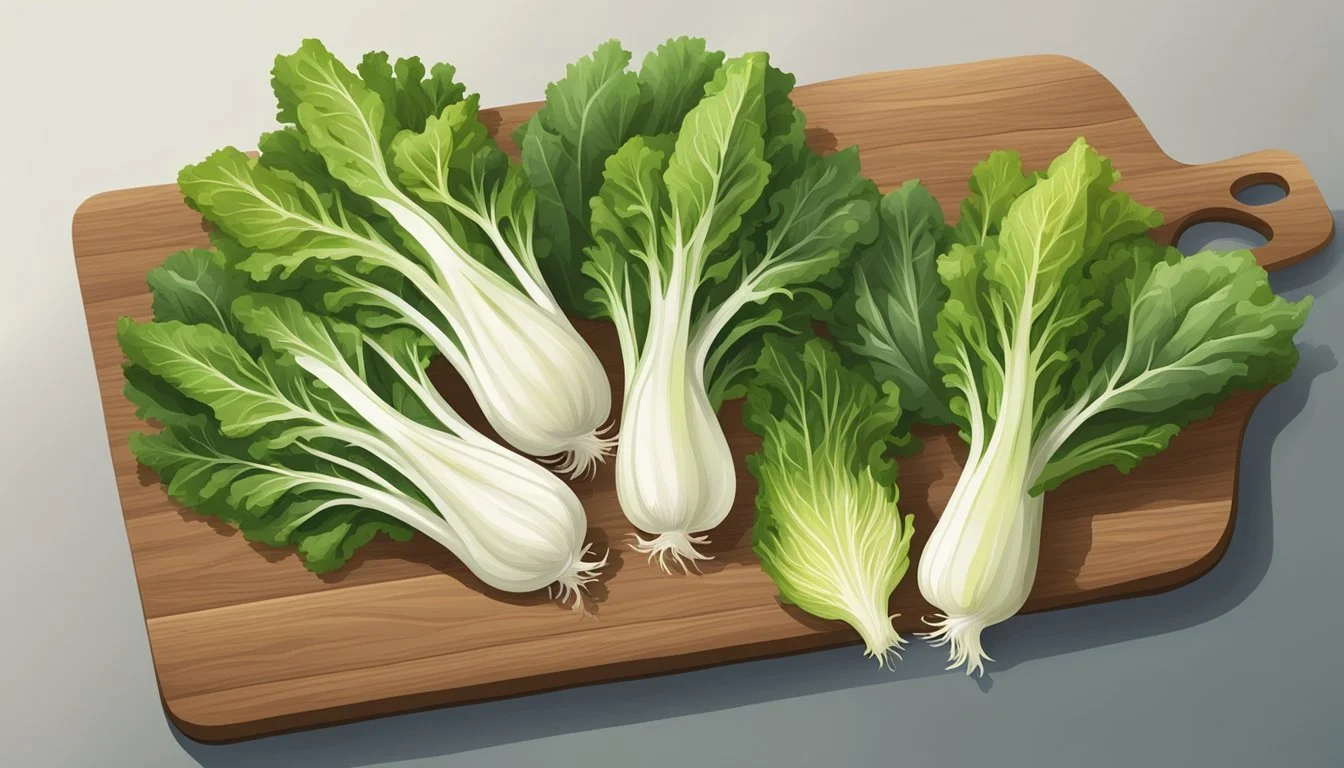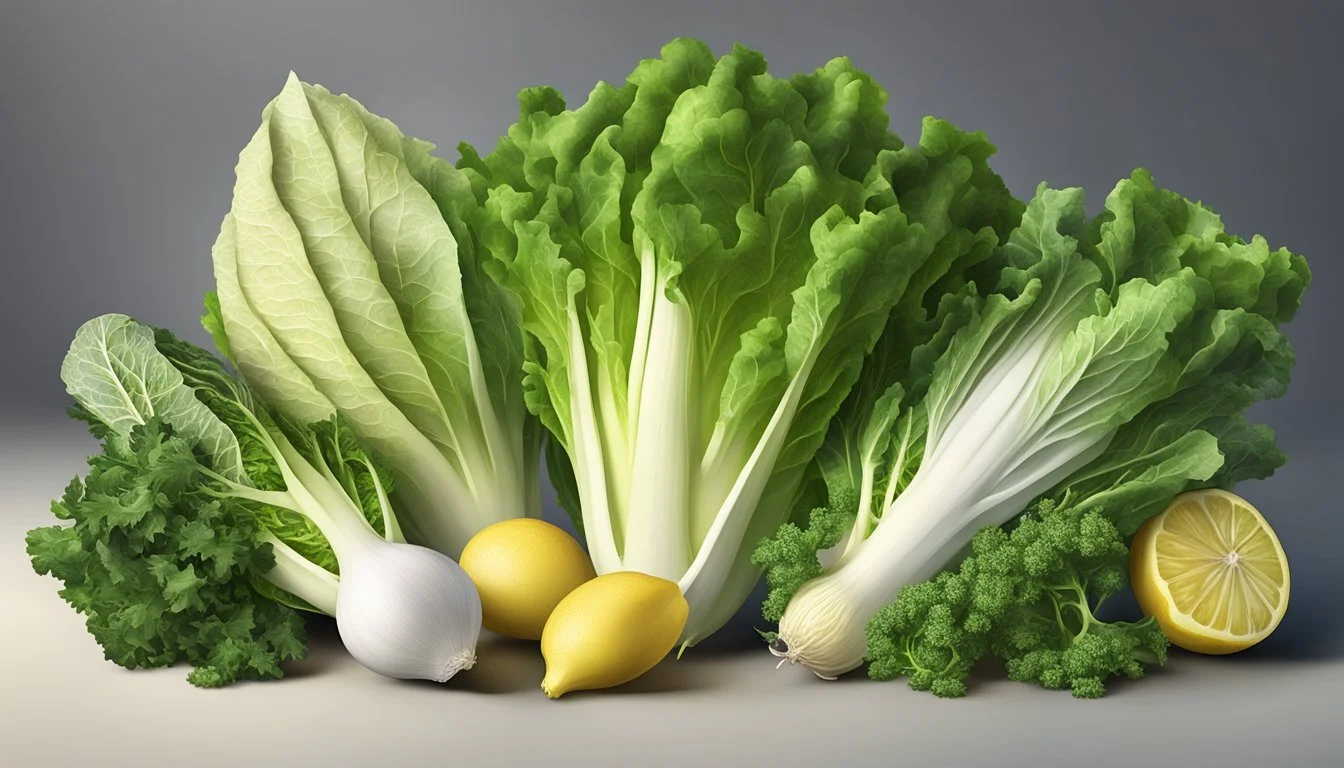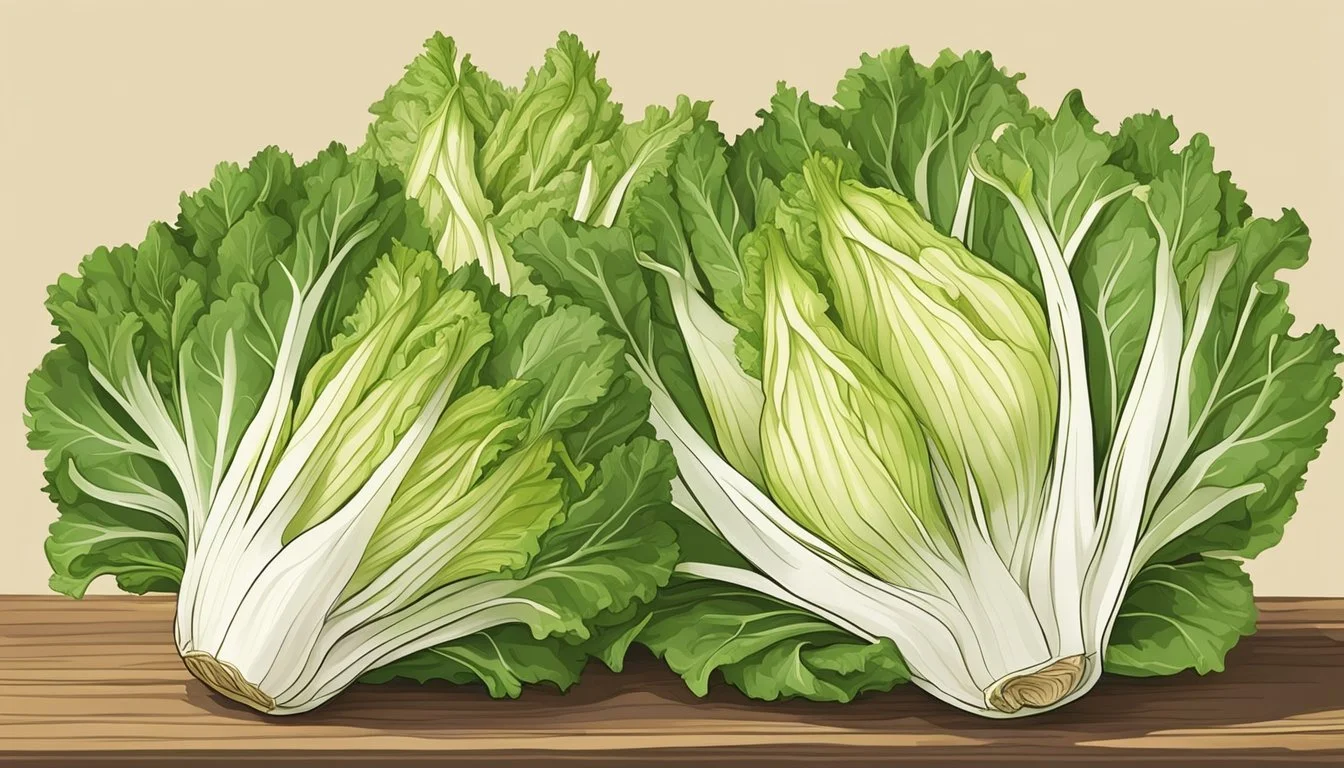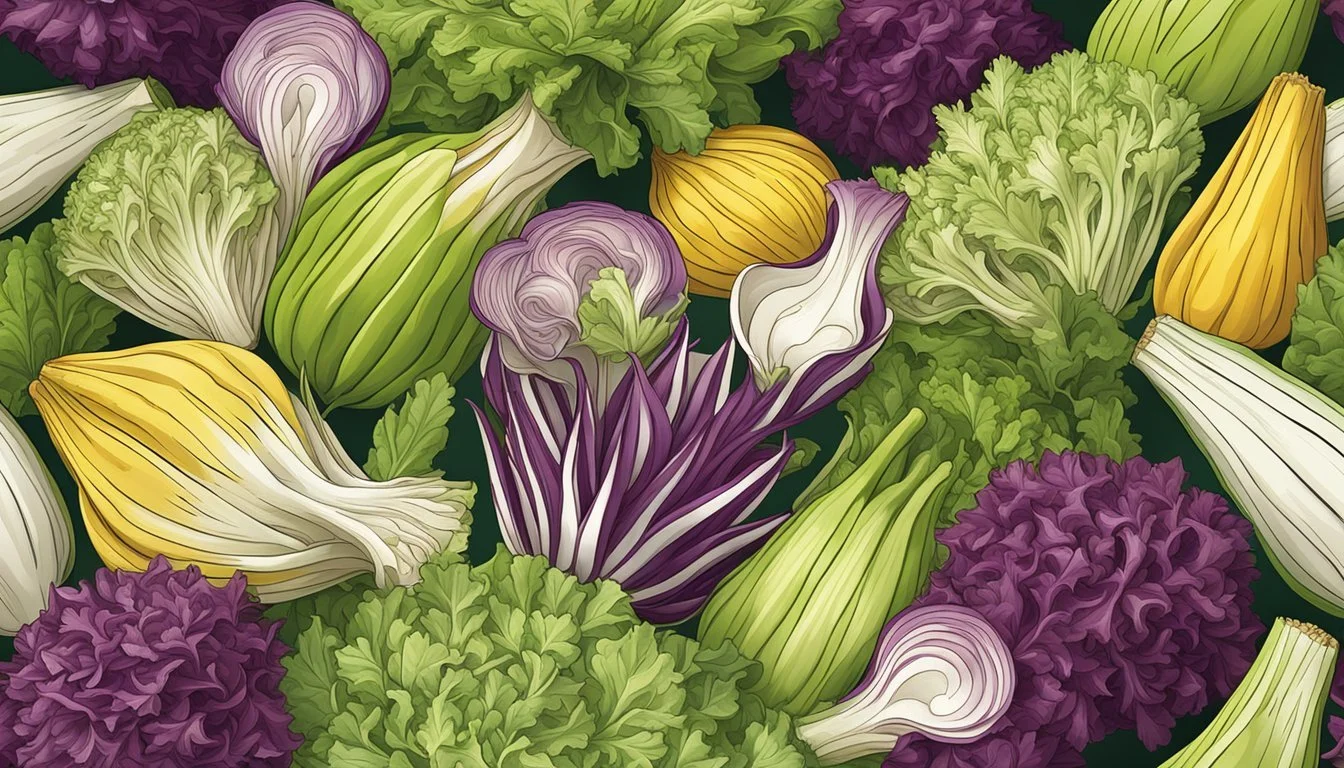Endive, Curly Endive Substitutes
Top Alternatives for Your Recipes
Endive, a leafy vegetable with a distinct bitter flavor, plays a vital role in many culinary traditions. Known in various forms, such as curly endive or Belgian endive, its crisp texture and slightly bitter taste make it an excellent choice for salads (What wine goes well with salads?) and as a garnish. Curly endive, also recognized as frisée, features frizzy leaves and is often included in mesclun salad mixes.
Finding a substitute for endive is necessary when availability is scarce or when a milder flavor is preferred in a dish. Suitable replacements include radicchio, known for its vibrant color and bold bitterness, which can be tempered by cooking techniques like grilling or roasting. Watercress offers a peppery note, while arugula brings a less bitter taste, yet maintains the characteristic peppery kick. Chicory leaves can be used for their flavor resemblance, while the milder napa cabbage and crunchy romaine lettuce act as softer alternatives in salads and other preparations.
When replacing endive in recipes, it is important to consider the texture and flavor desired in the final dish. While the alternatives can provide similar characteristics, each brings its own unique qualities, enhancing dishes with new dimensions of taste and presentation.
Understanding Endive
In exploring endive, one encounters a versatile leafy green that belongs to the chicory family, favored for its crisp texture and nuances of flavor. This section delves into the specific types of endive and their nutritional composition.
Types of Endive
There are mainly two types of endive commonly used in culinary applications:
Belgian Endive: Also known as French endive or witloof, this variety has a small, cylindrical head with pale yellow leaves. It's known for a slightly bitter and nutty flavor, which mellows when cooked.
Curly Endive (Frisée): Curly endive features lacy, green fringed leaves and a mildly bitter taste. Its distinct texture and tartness make it a popular salad ingredient.
Nutritional Profile
Endive is recognized for its rich nutritional profile, which includes a range of vitamins, minerals, and dietary fiber. Here's a brief overview:
Nutrient Benefit Vitamins Rich in vitamins A, C, E, and K, endive contributes to immune function, skin health, and blood clotting. Minerals Contains minerals like potassium and manganese, crucial for heart function and metabolism. Fiber A good source of dietary fiber, supporting digestive health and providing a feeling of fullness.
The information in this section presents endive as both a flavorful addition to a meal and a beneficial ingredient for maintaining a balanced diet.
Endive Flavor Profile
Endive, notable for its crisp texture and unique taste, is distinguished by bitter flavors that tend to mellow when cooked. The bitterness is attributed to the presence of certain compounds that are particularly concentrated in the white veins of the leaves.
An endive head consists of firm, tightly packed leaves that range in color from pale yellow to cream, with characteristic white veins running through them. The profile of an endive can be described as follows:
Raw: Intense and sharp with a noticeable bitterness.
Cooked: Subtler bitterness with a hint of sweetness.
Here's a brief breakdown of the flavor nuances of endive:
Condition Flavor Note Raw Sharply bitter Cooked/Grilled Mildly bitter, slightly sweet
Endive is versatile, serving as a sturdy base for salads or as a compliment to cooked dishes. When selecting endive for cooking or serving raw, one should consider the intensity of the bitterness and how it will pair with other components of the dish. The cooking process can transform the bitter flavor into a gentler, somewhat sweet flavor, allowing for more subtle pairings.
Culinary Uses of Endive
Endive, a member of the chicory family, holds a cherished place in culinary practices owing to its crisp texture and a pleasant bitter flavor. It is often integrated into diverse recipes, ranging from fresh salads to sophisticated garnishes, and plays a pivotal role in both raw and cooked preparations.
In raw applications, endive leaves are commonly utilized for their firm and slightly bitter leaves that add depth to salads. They make an appealing vessel for appetizers, conveniently cupping ingredients like cheeses, nuts, and fruits. These leaves add a refreshing crunch to dishes and stand up well to robust dressings.
Cooked Preparations:
Stir-fried: Endive can be quickly stir-fried, contributing a touch of bitterness that complements rich flavors.
Braised: When gently braised, endive leaves become tender and their bitterness mellows out, pairing well with sweet and acidic elements.
Grilled: Grilling endive accentuates its natural flavors, bestowing a smoky character to the dish.
In the realm of pasta dishes, endive can be both a star and a supporting ingredient. It lends its distinctive taste to creamy pasta, balancing out the richness, or can be finely chopped as a refreshing finish to a hearty bolognese.
In recipe development, utilizing endive requires understanding how its bitterness can harmonize with other components, ensuring a well-rounded flavor profile. Chefs often balance its assertive taste with sweeter ingredients or dressings, which can include fruit, honey, or reduced balsamic vinegar.
Ultimately, endive is an adaptable ingredient in the culinary world, offering both textural contrast and a unique taste that can elevate everyday cooking.
Storing Endive
Proper storage of endive is crucial to maintain its freshness and flavor. The following guidelines provide effective methods to store this leafy vegetable.
Refrigeration:
Endive should be stored in the refrigerator to preserve its quality. Prior to refrigeration:
Rinse the leaves gently under cold water.
Pat them dry with a paper towel to remove excess moisture, which can encourage rot.
Storage Method:
In the crisper drawer:
Place the endive in the crisper drawer of the refrigerator.
Use a perforated plastic bag or wrap it in a damp paper towel then place it inside a plastic bag.
In a sealed container:
Alternatively, endive can be stored in a sealed container with a layer of paper towels at the bottom to absorb moisture.
Temperature:
Ensure that the refrigerator temperature is set between 32°F to 40°F (0°C to 4°C), which is ideal for storing vegetables.
Avoiding Ethylene Producers:
Endive is sensitive to ethylene gas which accelerates ripening. Store it away from ethylene-producing fruits such as apples and bananas.
By adhering to these storage suggestions, one can expect endive to stay fresh for approximately 3-4 days. Monitoring the vegetable's condition during storage is advisable, and any signs of wilting or discoloration indicate it is past its prime.
Top Substitutes for Endive
Endive is known for its crisp texture and slightly bitter taste, making it a versatile ingredient in salads and other dishes. When unavailable, certain vegetables can serve as effective substitutes, maintaining the integrity of the original recipe.
Belgian Endive Substitutes
Belgian endive, with its tight, cylindrical head of pale, slightly bitter leaves, is often used raw in salads or cooked in various dishes. Ideal substitutes for Belgian endive include:
Radicchio: This leafy vegetable shares the bitterness of Belgian endive and adds a vibrant red color to dishes. It's best used raw or cooked to bring out a milder, sweeter flavor.
Romaine Lettuce: Although less bitter, it offers a similar crunch and can be used in both raw and cooked preparations.
Curly Endive Substitutes
Curly endive, often referred to as frisée, features frizzy leaves and a distinct peppery taste. Suitable substitutes are as follows:
Arugula: It provides a peppery bite similar to curly endive. Its leaves can make a good stand-in for the frizzy texture of frisée.
Escarole: This leafy green is less frizzled but offers a comparable level of bitterness.
General Endive Substitutes
When recipes call for endive and neither Belgian nor curly varieties are available, the following alternatives can be used:
Chicory Leaves: Closely related to endive, chicory brings a similar bitterness and works well in a variety of dishes.
Watercress: With a peppery flavor, watercress serves as a good substitute, especially in salads and sandwiches (What wine goes well with sandwiches?).
Napa Cabbage: For a milder taste and crunch, napa cabbage can replace endive in cooked or raw preparations.
Each of these substitutes brings a unique flavor and texture that, when chosen carefully, can closely mimic the qualities of endive in your recipes.
Substitute Flavor Comparisons
When cooking with substitutes for endive, one should appreciate the nuanced flavors each alternative brings to the table. Curly endive, known for its slight bitterness and crispness, can be replaced by a variety of greens, each with its distinctive flavor profile.
Radicchio possesses a bold, bitter flavor and adds a pop of color with its reddish-purple leaves. Though it shares curly endive's bitterness, radicchio can impart a subtle sweetness when grilled or roasted, mellowing its initial sharpness.
Arugula, in contrast, has a markedly peppery taste with a bit of nuttiness. Its texture is tender, yet the flavor is quite pronounced. Arugula can add an instant kick to salads and other dishes, differentiating itself from endive's straightforward bitterness.
Watercress offers a milder option with a gentle peppery bite, which doesn't overpower the palate. It contributes a fresh, aquatic note which can complement light dishes without altering their balance significantly.
Chicory, a close relative to curly endive, maintains a similar bitter profile but with a hint of earthiness. Its leaves are firmer, making chicory an excellent choice for holding up to heat in cooked dishes.
Substitute Main Flavor Characteristics Best Used In Radicchio Bitter, color-rich, sweet when cooked Salads, garnish, grilled Arugula Peppery, slightly nutty Salads, sandwiches Watercress Mildly peppery, fresh Cold dishes, salads Chicory Bitter, earthy Cooked dishes, robust salads
Each substitute brings a different dimension to dishes where one would typically use endive. Chefs should select based on the desired flavor outcome, taking into account the bitterness, sweetness, or peppery notes they wish to highlight.
Substitution Recommendations by Dish
When cooking with endive, chefs may find themselves needing a substitute for this leafy vegetable. Each alternative offers a different texture and flavor profile, suitable for various recipes.
Salads
For salads, arugula provides a peppery bite and is an excellent stand-in for curly endive's bitterness. Romaine lettuce, with its crispness, also works well, especially in Caesar salads. Chicory leaves, with their slightly bitter taste, can be used in equal parts to replace endive.
Cooked Dishes
In cooked applications such as soups and stews, watercress can serve as a substitute, introducing a mild, peppery flavor. However, one should add watercress towards the end of the cooking process to maintain its texture and taste. Napa cabbage is also a good alternative, adding sweetness and a tender crunch when cooked.
General Cooking
Radicchio, with its bold, bitter notes, can be used both raw and cooked, making it a versatile replacement. It stands out particularly when grilled or roasted, as the heat caramelizes the sugars and reduces its bitterness.
Substitute Best Used in Note Arugula Raw Salads Peppery flavor; different texture Romaine Raw Salads Crisp, less bitter Chicory Raw or Cooked Similar bitterness Watercress Lightly Cooked Dishes Add at the end; peppery flavor Napa Cabbage Cooked Dishes Sweet, crunchy texture Radicchio Raw or Cooked Reduces bitterness when cooked
One must consider the specific characteristics of these substitutes and how they will interact with the other ingredients in the dish. Chefs can achieve a similar appearance and flavor in their dishes with careful selection and preparation of these alternatives.
Nutritional Considerations in Substitutions
When substituting endive or curly endive in recipes, it is essential to consider the nutritional profile of the alternatives. Each leafy green offers a unique blend of vitamins, minerals, and dietary fiber which contribute to overall health.
Radicchio, a common substitute, is rich in vitamin K, important for bone health, and anthocyanins, which are antioxidants. Like endive, radicchio provides dietary fiber which aids in digestion.
Arugula, another recommended alternative, is lower in calories and offers vitamin C for immune support and potassium which is vital for heart function.
Chicory leaves share a similar nutrient profile with endive, including the presence of inulin, a type of fiber that supports gut health. Both chicory and endive are sources of vitamins A and K.
Watercress is a nutrient-packed leafy green, offering high levels of vitamin K, vitamin C, and calcium. Its high antioxidant content makes it a potent substitute in terms of nutritional value.
Including Napa cabbage as a substitute, one can benefit from its vitamin C and antioxidants as well as a milder taste compared to the slight bitterness of endive.
Lastly, Romaine lettuce provides a crisp texture with a lighter flavor. It is rich in vitamins A and K, and a source of folate.
Here is a brief comparison of the nutritional aspects of endive substitutes:
Substitute Key Vitamins Key Minerals Fiber Content Radicchio Vitamin K Iron High Arugula Vitamin C Potassium Moderate Chicory Leaves Vitamins A, K Calcium High Watercress Vitamins K, C Calcium High Napa Cabbage Vitamin C Selenium Moderate Romaine Lettuce Vitamins A, K Iron Moderate
When choosing a substitute for endive or curly endive, one should consider these nutritional factors to maintain a balanced diet.
Alternative Leafy Greens
For those who find themselves without endive or curly endive, there are several other leafy greens that can fill the gap in a recipe. Each brings its own flavor profile and texture, making them suitable for an array of dishes.
Chicory Leaves as a Substitute
Chicory leaves are a top alternative for endive, with a similar bitter taste and firm texture. They're an excellent choice for both raw and cooked applications, making them versatile. This includes the widely known radicchio, a type of chicory with red and white leaves, which offers a vibrant color and a slightly spicy bite that can add an attractive contrast to salads and garnishes.
Using Romaine and Iceberg Lettuce
For a crunchier texture, romaine lettuce and its closer relative, curly lettuce, can be used. They provide a milder flavor compared to endive and chicory. Romaine's long, sturdy leaves are particularly ideal for Caesars or robust, hefty salads.
Iceberg lettuce may also be used when a recipe calls for a crisp structure, but it should be noted that it offers less in terms of flavor and nutritional value compared to other alternatives.
Exploring Arugula and Watercress
Arugula and watercress are peppery greens that can replace endive to introduce a different but equally distinct flavor profile. They're more delicate but pack a punch with their bold, peppery notes:
Arugula: Lends an intense pepperiness that is perfect for salads, pesto, and garnishing dishes.
Watercress: With small, round leaves, it provides a light yet sharp peppery taste and works well in salads, soups, and sandwiches.
These substitutions keep dishes interesting and may even become new favorites for their unique contributions to flavor and texture.
Substitutes Beyond Leafy Greens
While endive is a common ingredient in salads and other dishes for its unique flavor and texture, there are instances where a cook might need to reach for something a bit different. This section explores how napa cabbage can serve as a bulkier, milder substitute, and how escarole and frisée can be used in a similar fashion to endive to maintain the integrity of a dish.
The Role of Napa Cabbage
Napa cabbage, with its sweet and milder flavor profile, stands out as an alternative to curly endive when a less bitter note is desired. Its leaves provide a pleasant crunch, and it can absorb accompanying flavors well, making it versatile for both raw and cooked preparations. For instance, napa cabbage can be sliced thinly for slaws or more substantially for stir-fries.
Raw Uses: Salads, slaws, wraps
Cooked Uses: Stir-fries, soups, steamed dishes
Incorporating Escarole and Frisée
Escarole is a type of endive that presents a less bitter taste than its curly counterpart. It can be used both raw and cooked, offering a robust texture and a slightly peppery flavor profile. In recipes calling for curly endive, escarole works well in hearty soups or braised dishes, where it retains its structure and slight bitterness.
Frisée, another member of the endive family, features finely fringed leaves and a mildly bitter flavor. This variety can be an excellent substitute for curly endive as it introduces a similar level of complexity to dishes with its texture and taste.
Escarole applications: Soups, stews, sautéed greens
Frisée role: Salad mixes, garnishes, light sautés
By leveraging the unique characteristics of napa cabbage, escarole, and frisée, cooks can create dishes that honor the essence of curly endive while introducing new dimensions of flavor and texture.
Texture and Crunchiness in Substitutes
When seeking substitutes for curly endive or Belgian endives, texture plays a pivotal role. Curly endive is known for its crispiness and slightly bitter taste, providing both a distinctive crunch and flavor to dishes.
Substitutes that cater to the crunchiness of curly endive include:
Radicchio: This leafy vegetable shares the bitter profile of endive. When raw, it retains a firm texture, ideal for adding a bite to salads.
Romaine Lettuce: Romaine echoes the crunchiness of endive, offering a similar texture in salads and other cold dishes.
Napa Cabbage: A softer crunch, but can be a good stand-in, especially in cooked preparations where a gentle texture is needed.
For Belgian endives, which are also prized for their textual nuance, suitable substitutes with comparable crunchiness include:
Chicory Leaves: These leaves mimic the crispiness and have a slight bitterness akin to Belgian endives.
Watercress: While it offers a softer texture, watercress can serve as a raw substitute in sandwiches or salads, adding a subtle, peppery crunch.
It’s important to note that cooking methods like grilling or roasting can accentuate the sweetness of vegetables such as radicchio, contrasting their natural bitterness while retaining their texture. The chosen substitute should align with the endive’s role in the dish, whether that’s providing a structural contrast or merely contributing to the overall crunch of the dish.
Maximizing Flavor in Substitutes
When one can't acquire endive for their culinary creations, several alternatives can be utilized not only to mimic endive’s texture but also to complement the flavor profile of the dish. Each substitute offers a different balance of bitter, sweet, and mild flavors, and understanding how to maximize these flavors is key to a successful substitution.
Radicchio is a vibrant substitution that brings a similar bitter punch but with a slight sweetness when grilled or roasted. This caramelization process accentuates the sweet flavors, contrasting with its natural bitterness. Use radicchio to add both visual appeal and a complex flavor profile to salads and cooked dishes.
For a milder bitter touch, arugula presents peppery notes which can complement salads, sandwiches, and even pizza. Its bitterness is less pronounced than endive, making it suitable for those who prefer a subtler bitterness.
If one desires an even more subtle bitterness, watercress could be the perfect addition. It should be used fresh in salads or sandwiches to maintain its crisp texture and mild peppery flavor.
Chicory leaves and escarole echo the bitter and robust qualities of endive but with a less intense flavor. These can be sautéed or used in soups and stews, where they contribute a mild bitterness without overpowering the other ingredients.
Table of Flavor Enhancement for Endive Substitutes:
Substitute Preparation Method Flavor Profile Best Used In Radicchio Grilled/Roasted Bitter-Sweet Salads, Garnish Arugula Fresh Mildly Bitter Salads, Pizzas Watercress Fresh Slightly Peppery Salads, Sandwiches Chicory Leaves Sautéed Mild to Moderate Bitter Soups, Stews Escarole Raw/Sautéed Slightly Bitter Salads, Soups
Choosing the correct substitute depends on how one wishes to balance the bitter, sweet, and mild flavors within their dish. Experimenting with different preparations can also uncover new dimensions to these versatile leafy greens.
Conclusion
When a recipe calls for endive and it's unavailable, culinary enthusiasts need not worry. There are several suitable substitutes that maintain the integrity of the dish while bringing a similar taste and texture to the table.
Radicchio stands out with its bold, bitter taste and crisp texture, a perfect stand-in for salads and garnishes. Arugula brings a peppery kick, ideal for a more pronounced flavor profile in raw preparations. Chicory leaves offer a nearly identical bitterness, making them excellent alternatives, especially in cooked dishes.
For those seeking a milder bitterness, watercress and romaine lettuce are viable options, alongside napa cabbage, which lends a sweeter note. Here’s a quick guide on how to substitute endive:
Substitute Taste Comparison Use Case Radicchio Bitter and crunchy Salads, garnish Arugula Peppery and fresh Salads, raw dishes Chicory Leaves Bitter and robust Cooked and raw dishes Watercress Mildly bitter Salads, sandwiches Romaine Lettuce Mildly bitter, crunchy Salads, wraps
To ensure success in the kitchen, chefs should consider the specific taste and texture contributions made by endive in their recipes and select the replacement that best matches the intended outcome. The key is balancing taste profiles and making adjustments where necessary to mimic the original flavor and consistency as closely as possible.





